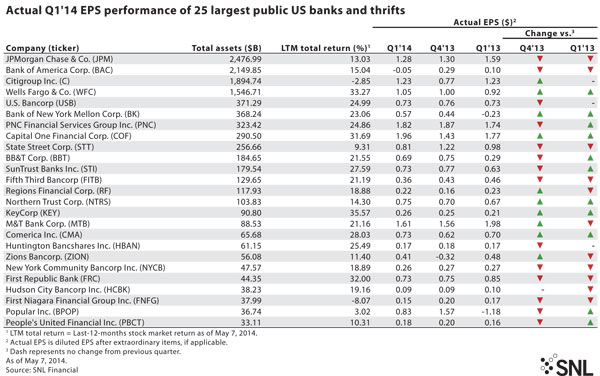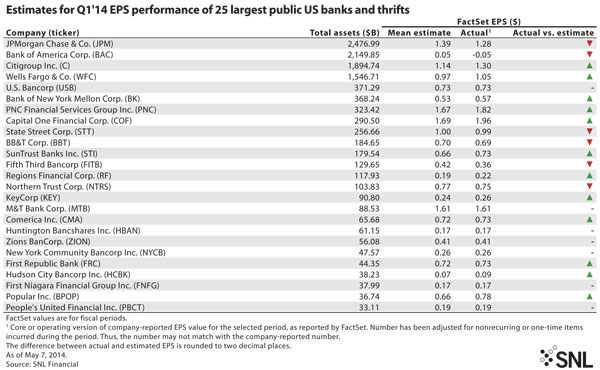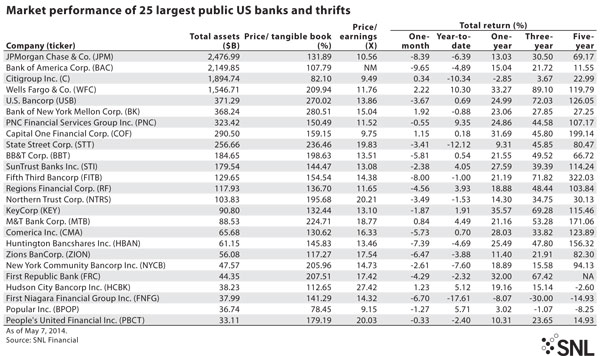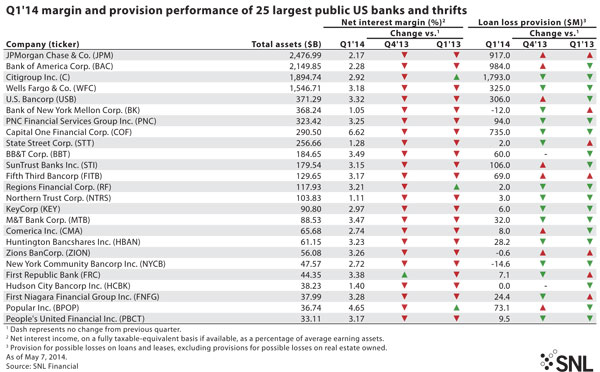Q1 scorecard for top 25 US banks and thrifts
SNL Report: Results split down the middle
- |
- Written by SNL Financial

By Divya Lulla and Nicole De Dios, SNL Financial staff writers
The top 25 publicly traded banks and thrifts reported mixed earnings growth trends in the first quarter.
Eleven of the 25 biggest public banks and thrifts in the U.S. reported that earnings per share improved in the first quarter from year-ago levels. Another 11 institutions reported lower EPS figures, while the remainder saw no change.
Earnings growth trends were even more favorable across a broader group of publicly traded banks and thrifts. SNL analyzed 403 out of 440 major-exchange-traded U.S. banks and thrifts that had reported first-quarter earnings as of May 7. Of that number, 57.82% saw year-over-year EPS growth, 5.21% saw no change, and 36.97% reported a decline in EPS from the prior year.
Closer look at biggest banks
Among the top 25 banks and thrifts, six showed linked-quarter and year-over-year EPS improvement: Wells Fargo & Co., Bank of New York Mellon Corp., Capital One Financial Corp., Northern Trust Corp., KeyCorp, and Comerica Inc.
On the other hand, seven of the top 25 showed declines from the prior quarter and year-ago period: JPMorgan Chase & Co., Bank of America Corp., State Street Corp., Fifth Third Bancorp, New York Community Bancorp Inc., First Republic Bank and First Niagara Financial Group Inc.
Bank of America was the only bank among the top 25 to report a net loss in the first quarter, largely due to $6.0 billion in litigation expenses. The company took analysts aback by posting a loss of 5 cents per share, 10 cents lower than consensus estimates.
Meanwhile, results from Citigroup Inc. topped analyst estimates for the first quarter. Citi, which disappointed in the fourth quarter of 2013 when its EPS came in 10 cents below analysts' expectations, rebounded to net income of $1.23 per share, compared to the FactSet mean estimate of $1.14 per share.
Citi had other issues to grapple with during the first quarter, including an objection to its Comprehensive Capital Analysis and Review submission and the discovery of fraud at its Banamex unit.
Closer look at the broad sample
The banking industry as a whole continues to battle pressure on net interest margins.
The median NIM of the 403 companies covered in the review fell 8 basis points quarter over quarter and 3 basis points year over year. Every bank in the top 25 saw NIM compress from the linked quarter—except First Republic. Margins fell year over year for all banks in the top 25 save for Citi, Regions Financial Corp., and Popular Inc.
Several companies touted improvements in credit quality and declines in nonperforming assets. Among the 403 companies in SNL's analysis, the median loan loss provision decreased to $300,000 from $460,000 in the fourth quarter of 2013 and from $498,000 in the year-ago quarter. However, several banks among the top 25 saw loan loss provisions increase quarter over quarter: SunTrust Banks Inc., U.S. Bancorp, Comerica, Popular, Fifth Third, BofA, and JPMorgan. Zions saw a recovery for loan losses, albeit a lower one than in the previous quarter. Hudson City Bancorp Inc. recorded no provision for loan losses.
 For a larger version, click on the image.
For a larger version, click on the image.
Efforts to rein in expenses carried over into the first quarter of 2014, as many companies continued branch consolidation efforts and headcount reductions in light of lower mortgage banking income.
JPMorgan, for one, has cut its number of mortgage banking employees by almost 3,000 since the end of 2013.
Fixed-income markets were another drag on earnings, although some banks' asset management operations were profitable during the quarter. JPMorgan's revenues from both fixed-income and equity markets dropped, while BofA reached a record-high for asset management fees. Several companies reported increases in deposits and improvement in lending activity, with the exception of mortgages, but also remarked on the issue of excess liquidity caused by the current rate environment.
In some cases, companies whose figures strayed from the trends pointed to seasonal factors and fewer calendar days.
Regulatory outlook clears
Despite the usual lobbying against regulations, there are signs that the uncertainty over their impact has somewhat abated—at least among larger institutions.
The American Bankers Association dropped its Volcker rule lawsuit. Shortly after regulators released the Volcker rule in December 2013, JPMorgan Chairman, President and CEO Jamie Dimon said he was " glad that we now have certainty," and that the bank would "be able to manage with Volcker at this point." Even a recently discovered accounting error at BofA, which led to the company resubmitting its capital plan—and Citi's CCAR rejection, to a certain degree, been shrugged off in light of otherwise strong numbers.
 For a larger version, click on the image.
For a larger version, click on the image.
 For a larger version, click on the image.
For a larger version, click on the image.
Tagged under Management, Financial Trends,
Related items
- How Banks Can Unlock Their Full Potential
- JP Morgan Drops Almost 5% After Disappointing Wall Street
- Banks Compromise NetZero Goals with Livestock Financing
- OakNorth’s Pre-Tax Profits Increase by 23% While Expanding Its Offering to The US
- Unlocking Digital Excellence: Lessons for Banking from eCommerce Titans













